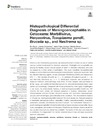Identificador persistente para citar o vincular este elemento:
https://accedacris.ulpgc.es/jspui/handle/10553/75087
| Título: | Histopathological Differential Diagnosis of Meningoencephalitis in Cetaceans: Morbillivirus, Herpesvirus, Toxoplasma gondii, Brucella sp., and Nasitrema sp. | Autores/as: | Sierra Pulpillo, Eva María Fernández Rodríguez, Antonio Jesús Felipe Jiménez, Idaira Del Carmen Succa, Daniele Diaz Delgado, Josue Puig Lozano, Raquel Câmara, Nakita Consoli, Francesco Díaz Santana, Pablo José Suarez Santana, Cristian Manuel Arbelo Hernández, Manuel Antonio |
Clasificación UNESCO: | 310907 Patología 3105 Peces y fauna silvestre 240119 Zoología marina |
Palabras clave: | Brucellasp Cetaceans Herpesvirus Meningoencephalitis Morbillivirus, et al. |
Fecha de publicación: | 2020 | Publicación seriada: | Frontiers in Veterinary Science | Resumen: | Infectious and inflammatory processes are among the most common causes of central nervous system involvement in stranded cetaceans. Meningitis and encephalitis are among the leading known natural causes of death in stranded cetaceans and may be caused by a wide range of pathogens. This study describes histopathological findings in post-mortem brain tissue specimens from stranded cetaceans associated with five relevant infectious agents: viruses [Cetacean Morbillivirus (CeMV) and Herpesvirus (HV); n = 29], bacteria (Brucella sp.; n = 7), protozoa (Toxoplasma gondii; n = 6), and helminths (Nasitrema sp.; n = 1). Aetiological diagnosis was established by molecular methods. Histopathologic evaluations of brain samples were performed in all the cases, and additional histochemical and/or immunohistochemical stains were carried out accordingly. Compared with those produced by other types of pathogens in our study, the characteristic features of viral meningoencephalitis (CeMV and HV) included the most severe and frequent presence of malacia, intranuclear, and/or intracytoplasmic inclusion bodies, neuronal necrosis and associated neuronophagia, syncytia and hemorrhages, predominantly in the cerebrum. The characteristic features of Brucella sp. meningoencephalitis included the most severe and frequent presence of meningitis, perivascular cuffing, cerebellitis, myelitis, polyradiculoneuritis, choroiditis, ventriculitis, vasculitis, and fibrinoid necrosis of vessels. The characteristic features of T. gondii meningoencephalitis included lymphocytic and granulomatous encephalitis, tissue cysts, microgliosis, and oedema. In the case of Nasitrema sp. infection, lesions are all that we describe since just one animal was available. The results of this study are expected to contribute, to a large extent, to a better understanding of brain-pathogen-associated lesions in cetaceans. | URI: | https://accedacris.ulpgc.es/handle/10553/75087 | DOI: | 10.3389/fvets.2020.00650 | Fuente: | Frontiers in Veterinary Science [EISSN 2297-1769], v. 7, (Septiembre 2020) |
| Colección: | Artículos |
Citas SCOPUSTM
26
actualizado el 08-jun-2025
Citas de WEB OF SCIENCETM
Citations
25
actualizado el 08-jun-2025
Visitas
272
actualizado el 04-ene-2025
Descargas
260
actualizado el 04-ene-2025
Google ScholarTM
Verifica
Altmetric
Comparte
Exporta metadatos
Los elementos en ULPGC accedaCRIS están protegidos por derechos de autor con todos los derechos reservados, a menos que se indique lo contrario.
